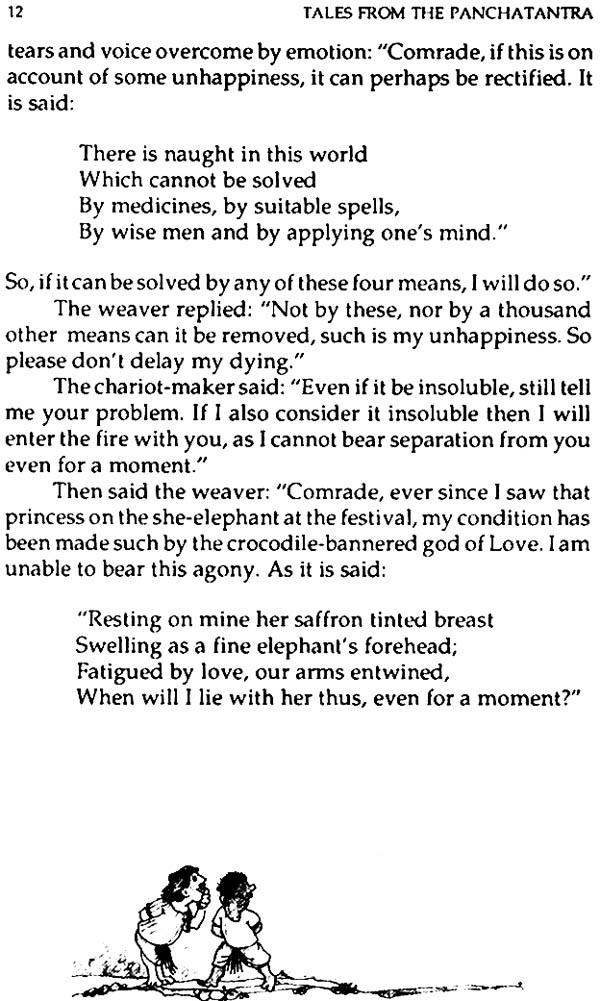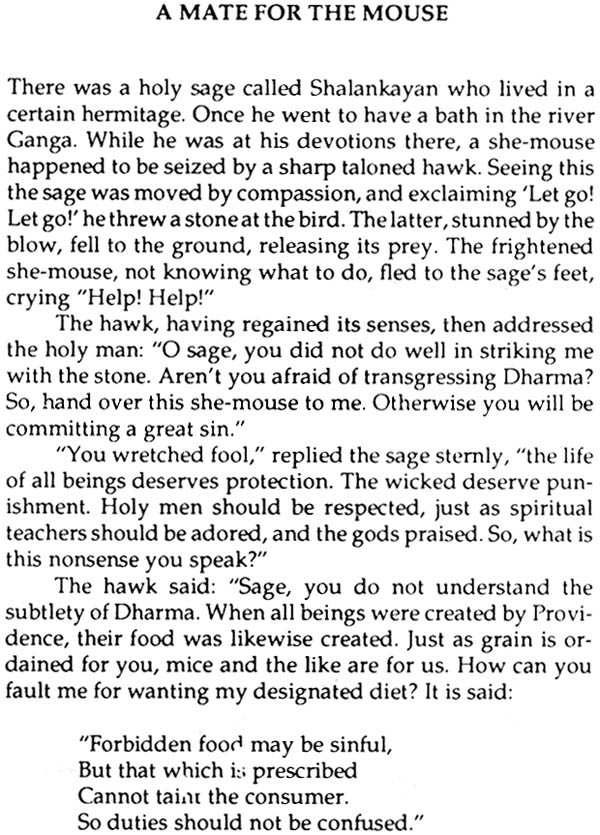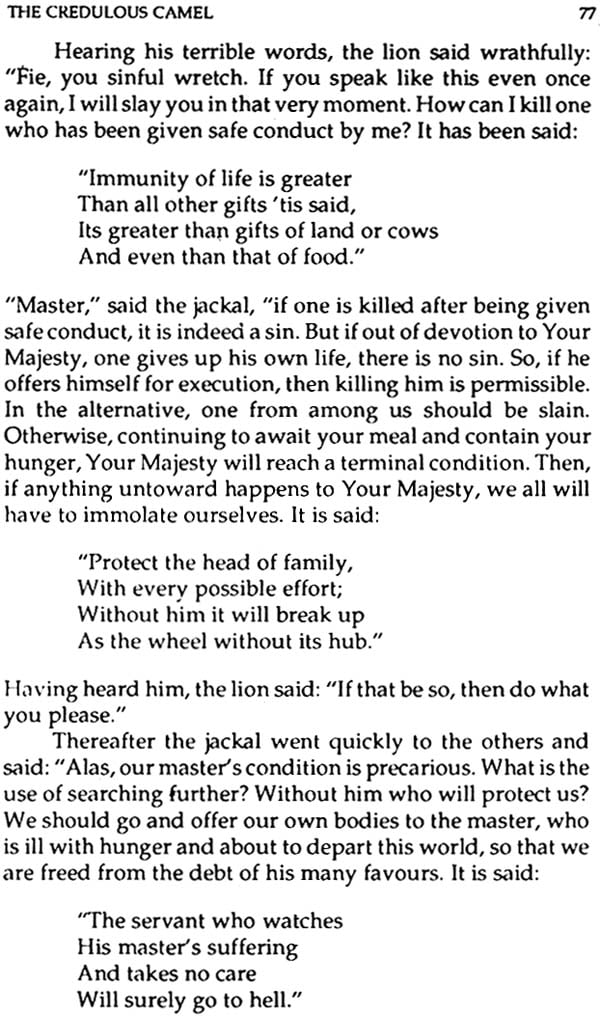
Tales From The Panchatantra
Book Specification
| Item Code: | NAF519 |
| Author: | A.N.D Haksar |
| Publisher: | National Book Trust, India |
| Language: | English |
| Edition: | 2018 |
| ISBN: | 9788123700212 |
| Pages: | 105 (42 B/W Illustrations) |
| Cover: | Paperback |
| Other Details | 8.5 Inch x 5.5 Inch |
| Weight | 90 gm |
Book Description
Since 1994 our Udbodhan publication center has brought out four volume of rare reminiscences entitled Sri Sri Padaprante which were published in Bengal during last one hundred years in different journals and books.
These reminiscences were collected and edited with great labour and Sacrifice by the then editor of Udbodhan swami purnatmanadaji along with a group of dedicated scholars. We sincerely congratulate all of them for their significant contribution to the Ramakrishna sarada literature. We have translated some of them in English so that these rare and unknown dimensions of our Divine Mother can be read by a wider non-Bengal reading public.
We are grateful to Rev. Swami Satyavratanandaji President Ramakrishna Math Udbodhan for his kind consent for his publication. In this book the numerals before the colon refer to have volume numbers and those after the colon refer to the page number in those four volumes. We have also included a short illustrated life of Holy Mother and three small plays on her life and message which have already been successfully staged by students in English Bengali and Gujarati.
We hope this small booklet will increase our love and devotion four our Holy Mother.
The Panchatantra is one of the best known classics of ancient India. Composed in Sanskrit about 1600 years ago, its lively stories, and its simple but vivid prose punctuated by pithy verses, assured it a continuing place of prominence in classical literature through the centuries. On account of its uncomplicated and easy to understand Sanskrit it was particularly popular as a text for beginners in the study of that complex language. Hence the misconception that it is suitable only for children. On the contrary it has an appeal for all ages.
Panchatantra means Five Books or Systems. It is a collection of nearly ninety stories and stories within stories. The characters in these fables are animals as well as humans. The settings are situations of everyday life in towns and villages, in palaces, on farms and in forests. The mood ranges from the didactic and cynical to the ribald and comic. The characters enact the foibles and follies, the virtues and the villainies of human conduct. They utter wise words and perform good deeds as well as indulge in every kind of sharp practice. Set in ancient India, they could exist at any time or place.
The five books of the Panchatantra have the titles: Losing Friends, Making Friends, Of Crows and Owls, Loss of Gains, and Rash Actions. The author was perhaps Vishnu Sharma, the narrator of the main story in the work. It is difficult to trace the city of Mahilaropya where it is set. Some scholars think it was in the Vakataka Empire in the Deccan. The genre of the composition is the nidarshanakatha or illustrative story, which is satirical and intended to teach by example. As indicated at their beginning, the stories were composed to simple and effective way.
The Panchatantra is one of the first sets of stories to have travelled from one civilization" to another through the medium of translation. It was rendered into Pehlavi or middle Persian in the sixth century A.D. on the orders of the Sasanian king Anushirvan. Thereafter it was translated into Syriac and later into Arabic in the time of the Caliph al- Mansur (AD. 753-84). The Arabic title Kalilah wa Dimnah is considered to be derived from Karataka and Damanaka, the names of two jackals who play a leading part in some of the stories. Subsequent translations were made into Spanish and other European languages in a variety of forms. La Fontaine acknowledged the Indian source when he wrote his fables in seventeenth century France.
The Panchatantra is also of historic interest as, apart from giving interesting descriptions of social life and attitudes, it also refers to earlier Indian writers like Panini, Chanakya and Vatsyayana. The earliest extant version of its original text is believed to have come from eleventh century Kashmir. It was introduced to the modern world by German scholars in the last century. The best known English translations were made by the American orientalists F. Edgerton in 1924 and A.W. Ryder in 1925. Sixty five years later a selection of the Panchatantra tales for the modern reader is presented here in a new translation from the original Sanskrit text.
All these translations first appeared either in the "States- man", New Delhi, during 1988 or in the "National Herald", New Delhi, during 1990. The translator would like to thank the Editors of both the newspapers for agreeing to their publication in book form. He is also grateful to his colleagues Shri Tajinder Singh and Shri M.L. Nankani for their help in preparing the typescript. Above all, he thanks Shrimati Priti Haksar, his wife, for her unfailing support.
| 1 | Holy Mother Sri Saradadevi | 1 |
| 2 | Mother and Sri Ramakrishna | 15 |
| 3 | Mother and Naren | 24 |
| 4 | Mother and Her sons | 29 |
| 5 | Mother of Devotees | 33 |
| 6 | Mother-Saviour | 36 |
| 7 | Mother of All | 40 |
| 8 | Mother in Her Divine form | 40 |
| Three Plays on Holy Mother | ||
| 1 | Divine Mother awakens in Sarada | 57 |
| 2 | Dacoit Amzad’s Eternal Mother | 62 |
| 3 | The Holy Mother of All | 69 |















